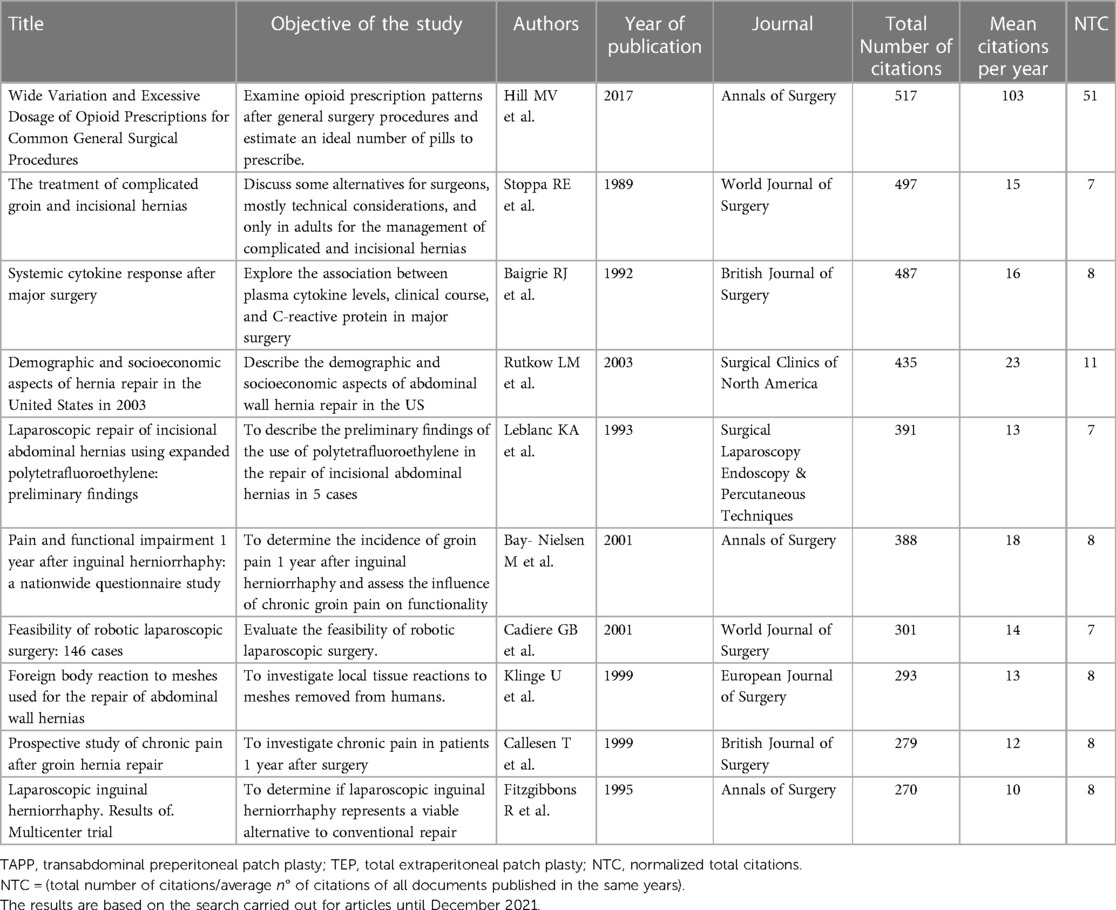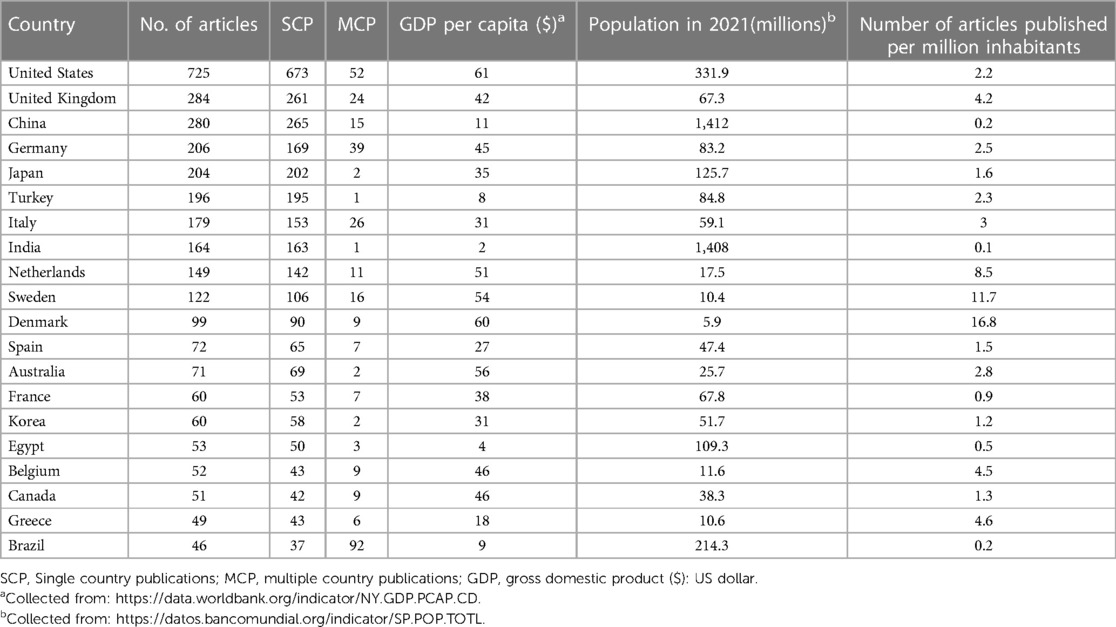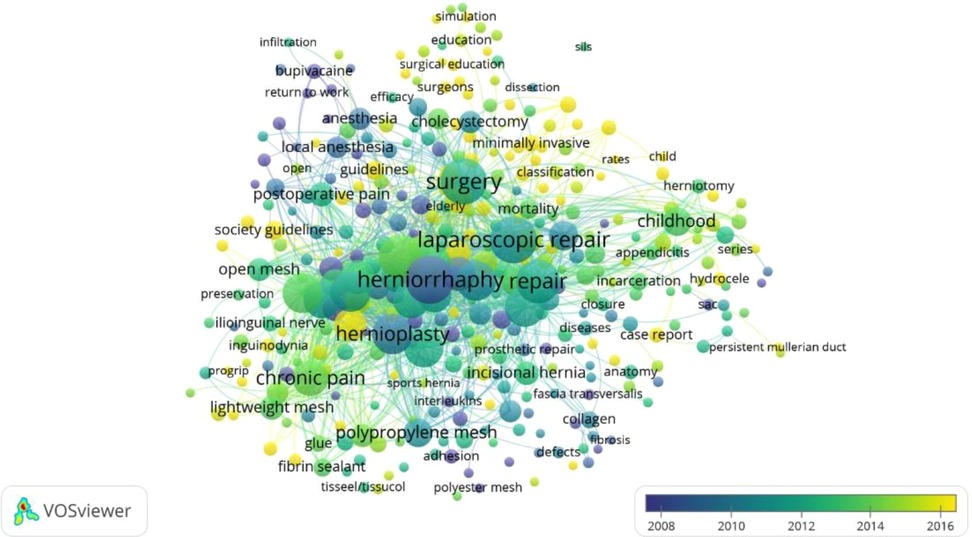Bibliometric analysis of the scientific production on inguinal hernia surgery in the web of science
- 1Universidad Cientifica del Sur, Lima, Peru
- 2Centro de Excelencia en Investigaciones Económicas y Sociales en Salud, Vicerrectorado de Investigación, Universidad San Ignacio de Loyola, Lima, Peru
- 3Hospital III Jose Cayetano Heredia, EsSalud, Piura, Peru
Objectives: To describe the bibliometric characteristics of the world scientific production in inguinal hernia surgery using the Web of Science Core Collection (WoS) database.
Materials and methods: A search for original articles published in the WoS up to December 2021 was carried out. Bibliometric analysis was performed using the Bibliometrix data package in R and VOSviewer, version 1.6.17.
Results: A total of 3,795 articles were identified in the database, with an annual average of 81 published articles and sustained growth with the highest number of publications in 2021. The article “Wide Variation and Excessive Dosage of Opioid Prescriptions for Common General Surgical Procedures” published in 2017 was the most cited (517 citations). The United States was the country of the corresponding author with the highest number of published articles (725 articles). The author with the highest number of published articles was Rosenberg J., affiliated with the University of Copenhagen, with 52 articles and 765 citations. The journal “Hernia” had the highest number of articles published on inguinal hernias in the WoS, representing 18% of the total number of articles. Finally, the keywords most used were “herniorrhaphy” and “hernioplasty” in 2008, and more recently: “single incision” “society guidelines” and “single port”.
Conclusions: The scientific production of original articles on inguinal hernia surgery has increased. There is currently great interest in research on minimally invasive surgical methods and standardization of procedures based on clinical practice guidelines.
1. Introduction
Inguinal hernias account for more than 75% of all abdominal wall hernias, and an incidence of 13 per 10,000 population (1, 2). This abdominal wall defect causes abdominal pain and, consequently, significantly affects people's quality of life and mood, interfering with their daily and occupational activities (3). Therefore, around 20 million people worldwide undergo surgery through various techniques to repair hernia defects (4, 5). In this sense, research on inguinal hernia is necessary to obtain greater knowledge about the epidemiological aspects of the disease, as well as monitor and evaluate the efficacy and safety of health technologies aimed at its surgical management, and understand the evolution of techniques for surgical repair of hernia defects (5).
Bibliometric studies make it possible to measure and analyze the scientific production of different countries or regions and provide a general overview of certain research topics. This type of research is necessary to systematically verify and summarize this information due to the increase in the number of publications (6). Likewise, these studies show the impact and trends of scientific publications, in addition to retrospectively examining how scientific advances have been obtained and publicized (7). This information is useful for understanding the current scientific situation and guiding future research in different areas of science, including the field of surgery. In this regard, the Web of Science (WoS) Core Collection is one of the oldest databases and one of the most used in research, allowing the search for publications, analysis of citations, and other aspects and facilitating bibliometric analyses (8), since it indexes publication records of scientific journals with the greatest impact in the world. Currently, the WoS has more than 21 thousand journals, of which more than 5 thousand belong to health sciences (9).
Currently, bibliometric studies cover abdominal wall hernias; however, no bibliometric analysis of the publications on inguinal hernia, which is the most frequent condition among abdominal hernias, has been developed (10). Likewise, this condition presents particular anatomical and pathophysiological characteristics that require differentiated surgical management compared to other types of hernias, and thus, it is necessary to evaluate the bibliometric characteristics of the publications on the surgery performed in this condition (11).
The present study aimed to evaluate the bibliometric characteristics of the global scientific production of original articles on inguinal hernia surgery in the WoS Core Collection database. This analysis may be useful for professionals seeking guidance related to specialization opportunities in the field of inguinal hernia surgery and may be used for decision-making at the level of governments, universities, and research centers/groups to reorient funding and research priorities in this area.
2. Materials and methods
A bibliometric analysis of original articles on inguinal hernia indexed in the bibliographic database of the WoS Core Collection from inception up to May 12, 2022, was performed (9). All the publications on inguinal hernia surgery, categorized as original articles and published in WoS Core Collection up to December 2021 were included. Documents such as guidelines, consensus, errata, letters to the editor, scientific letters, editorials, corrections, retracted articles, retraction notes, and articles published in languages other than English, Spanish, or Portuguese were excluded. Only articles published until 2021 were considered because the year 2022 was still ongoing at the time of the study. The WoS Core Collection database was used as the source for this bibliometric analysis since it is a platform with access to reliable and high-quality information, and indexes records of articles of the journals with the greatest impact in the world, thereby allowing the search for articles, citation analysis and other data to facilitate bibliometric analyses (8, 9).
2.1. Search strategy
The following search terms were used: #1, TS = (“inguinal hernia”); #2, TS = (“groin hernia”); #3, TS = (inguinal AND hernia*); #4, TS = (groin AND hernia*); #5, #1 OR #2 OR #3 OR #4, where TS means “title and subject”; and were searched in the categories of “Surgery” and filtered to those of the type “Article”; we used the Science Citation Index Expanded (created in 1964) of WoS Core Collection (12). The search terms were proposed by one of the authors (AHV) and validated by the remaining authors, one of whom is a pediatric surgeon (RDR).
2.2. Selection of articles
The metadata from the full records obtained from the search were collected and downloaded as “ciw” files. Subsequently, using Rayyan (13), two authors (EICC and JYEQ) independently reviewed and selected the articles by titles, abstracts, and keywords jointly, taking into account the inclusion and exclusion criteria. Later, discrepancies were resolved jointly between the two authors (EICC and JYEQ). Next, a list was prepared, on which the WoS “Accession Number” of each record not included was recorded to repeat the search, excluding these records. After this process, the final files of the complete records were obtained for bibliometric analysis.
2.3. Bibliometric analysis
The bibliometric indices of the articles published for the study were obtained using the VOSviewer software and the data package Bibliometrix in R (14, 15). Also, data standardization of the data from authors, affiliations, and keywords of the records obtained was carried out manually by two authors of the present study (EICC and JYEQ) with the aim of eliminating redundancies. To do this, txt format thesauri were created, separating the data into two columns (labeled and replaced by), as recommended by the VOSviewer user manual. Subsequently, VOSviewer version 1.6.17 software was used to create co-authorship networks based on the authors, affiliations, and occurrence of retrieved records and how these change over time. Microsoft Excel was used to elaborate the corresponding tables and graphs. Network analysis was carried out using the fractional counting method, and only in the case in which the occurrence was a threshold of five mentions used for co-occurrence in titles and abstracts.
We aimed to report the following outcomes: total articles, total citations, average number of articles published annually, trends of articles and citations over the years, the ten most cited articles on inguinal hernia (including: objective of the study, author, publication year, journal, total number of citations, mean citations per year, and normalized total citations-NTC), the twenty corresponding authors countries with the highest number of published articles (including: number of articles, single country publications, multicounty publications), the ten authors with the highest production of articles on inguinal hernia (including: number of articles, total number of citations, percentage of total articles published, country and affiliation), the twenty journals with the highest number of articles published (including: number of articles, percentage of total articles, impact factor and quartile category), co-authorship network according to authors, co-authorship network according to institutional affiliations, and co-occurrence network of keywords. The Normalized Total Citations (NTC) is calculated by the Bibliometrix in R by dividing the total number of citations of an article by the average number of citations of all documents published in the same year; this measure takes into account differences in citation practices across disciplines and provides a more meaningful comparison of citation impact (16). Also, when creating the co-occurrence network of keywords, we excluded the keywords “inguinal hernia”, “hernia”, “groin” and “groin hernia” because they were the main topics of the articles in the database, and their inclusion would have made it difficult to elucidate other research topics related to the hernial condition.
In addition, the GDP per capita of the countries that are among the twenty corresponding authors countries with the highest number of published articles and the population size of each country were collected from the World Bank website (17, 18); the country's population size will be used to calculate the number of articles published per million inhabitants. Finally, we collected quartile classification data from the top twenty journals with the highest number of published articles. This data was obtained from the Journal Citation Reports website; which classifies journals from Q1 to Q4, where Q1 corresponds to “Highest ranked journals in a category” and Q4 corresponds to “Lowest ranked journals in category” (19).
2.4. Ethical considerations
The conduct of the study did not require the approval of an ethics committee because it was an analysis of the records of studies published in a database. The Universidad Científica del Sur approved the execution of this study than will serve as a partial requirement for two of the authors to obtain their bachelor's Degree (EICC and JYEQ).
3. Results
We conducted a search in the WoS and found a total of 4,025 articles on inguinal hernia. After evaluating the titles and abstracts in Rayyan, we obtained 3,795 articles in the database, with an average of 81 articles published annually. These articles received a total of 71,349 citations. Figure 1 illustrates the trend in articles published and citations on the subject since 1975, showing that the highest number of articles published was reached in 2021, while the highest number of citations was observed in 2003.
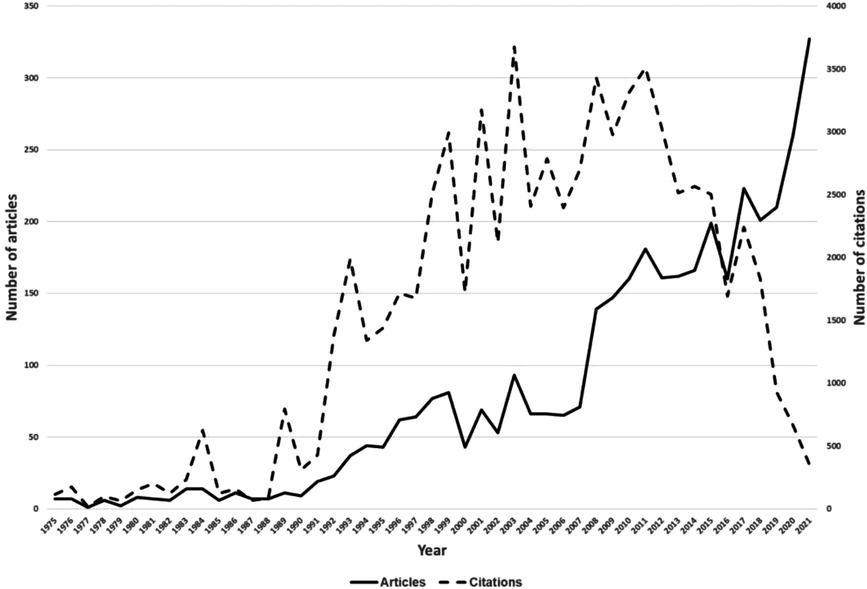
Figure 1. Trend of citations and articles published in web of science until 2021. The trend is represented by a polynomial trend line of degree 2.
The 10 most cited articles on inguinal hernia in the WoS had a total citation range between 270 and 517. The article with the highest number of citations (517) was titled “Wide Variation and Excessive Dosage of Opioid Prescriptions for Common General Surgical Procedures” (20), published in Annals of Surgery in 2017. The other articles in the top 10 described diverse topics, such as the biochemical aspects of inguinal hernias, surgical techniques, and complications (Table 1).
The United States had the highest number of published articles with a corresponding author affiliated with the country, with 725 articles, followed by the United Kingdom and China, with 284 and 280 articles. In terms of publications with authors from the same country, the United States led with 673, followed by China with 265 and the United Kingdom with 261. In relation to multiple country publications, Brazil led with 92 articles, followed by United States with 52, and Italy with 26. Table 2 also provides the gross domestic product per capita of the corresponding author countries, with the highest GDP per capita of $ 61 dollars in the United States, followed by $ 60 dollars in Denmark and $ 56 dollars in Australia. On the other hand, the country with the highest number of articles published per million inhabitants is Denmark, with 16.8 articles, followed by Sweden and the Netherlands (Table 2).

Table 3. The ten authors with the highest production of articles on inguinal hernia in the Web of science.
Rosenberg J., affiliated with the University of Copenhagen, had the highest production of articles on inguinal hernia, with a total of 52 published articles and 765 citations, followed by Kockerling F. (44 articles and 1,015 citations), and Nordin P. (42 articles and 1,636 citations) (Table 3). The top 10 authors with the most publications on inguinal hernia were affiliated with Denmark, Germany, Sweden, and Netherlands. Among them, Bittner, R and Sandblom, G, had a higher publication frequency around 2010. In addition, Amid and Kald presented the greatest scientific production on the subject in the 2000s (Figure 2).
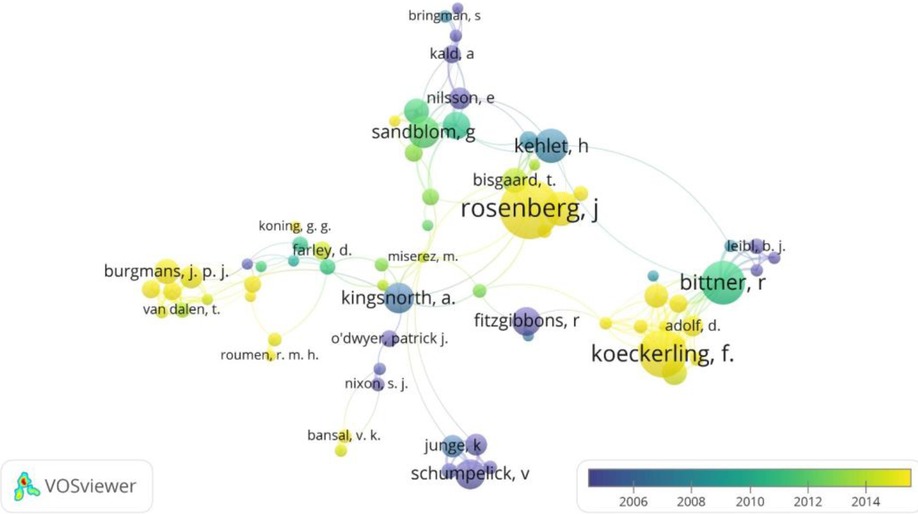
Figure 2. Bibliographic coupling network of authors with the greatest number of articles published in the web of science database.
Hernia had the highest number of articles published on inguinal hernia in the WoS, with 687 articles, representing 18% of the total articles included in the analysis. Surgical Endoscopy and other Interventional Techniques was in second place with 351 articles (9% of the total) followed by the Journal of Laparoendoscopic & Advanced Surgical Techniques with 173 articles (5% of the total). Annals of Surgery had the highest impact factor of 12.96, as compiled from Journal Citation Reports in Clarivate, followed by the British Journal of Surgery with 6.94 and the Journal of The American College of Surgeons with 6.113. According to the WoS classification, most journals were Q1, 4 belonged to Q2, 5 to Q3, and 3 to Q4, (Table 4).
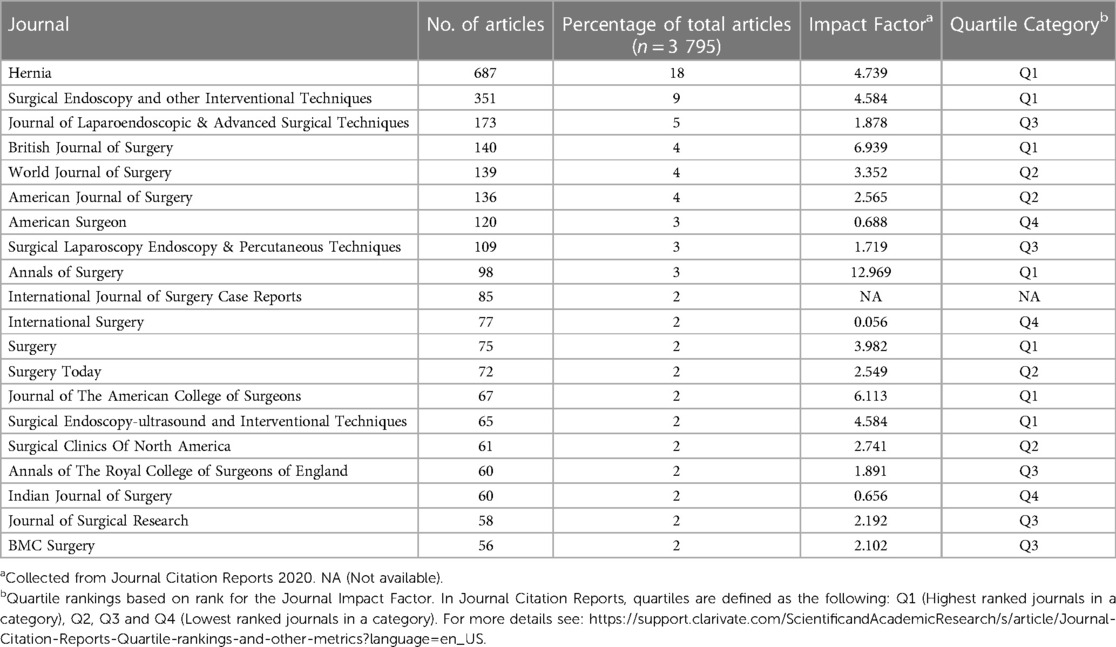
Table 4. The twenty journals with the highest number of articles published on inguinal hernia in the web of science.
In the network of co-occurrence of the most used keywords in the WoS Core Collection database, the terms “herniorrhaphy” and “hernioplasty” were the most frequently used in 2008. In the following years, new terms have been used in research like “laparoscopic repair” and “surgery” having a higher frequency of use between 2010 and 2012. Finally, in 2016, the use of terms such as “society guidelines”, “single incision”, and “single port”, among others, increased. Additionally, the terms “simulation” and “surgical education” started to be used from the middle of 2014 onwards (Figure 3).
In the cluster analysis map regarding the institutional affiliations that produced literature on hernia surgery (Figure 4, “univ Copenhagen hosp” had the highest scientific production on the subject from 2012 to 2014. “Johns Hopkins univ,” “Erasmus univ” and “Creighton univ” presented a considerable level of literature production on the subject during the same period. Since 2016, the “Capital med univ” has been leading production followed by the “German red cross hosp”.
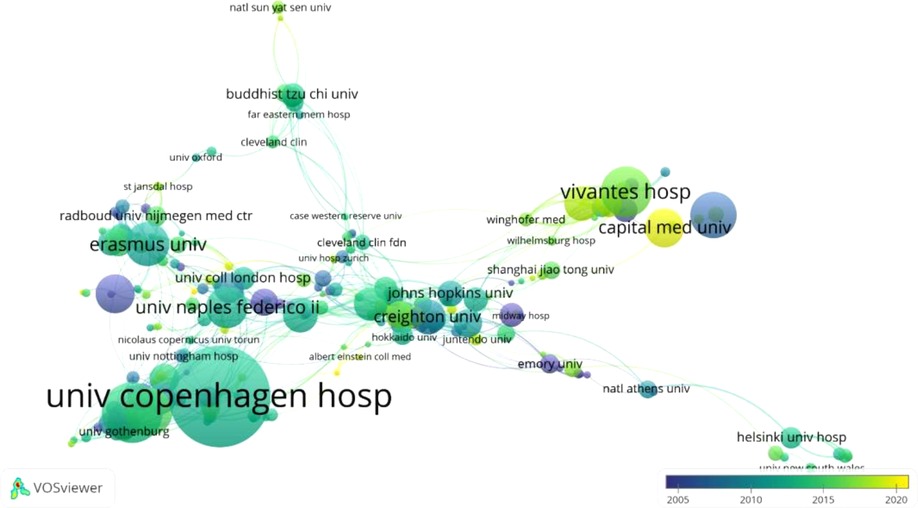
Figure 4. Bibliographic coupling network of institutions with the highest scientific production in the web of science database.
4. Discussion
The study aimed to evaluate the bibliometric characteristics of the global scientific production of original articles on inguinal hernia surgery in the WoS Core Collection database until December 2021. The analysis revealed a continuous growth in the scientific production on this topic, from 1990 to the search date, in which Rosenberg J. had the highest production of articles on inguinal hernia with 52 publications, representing 1.4% of all included publications. The most cited article was “Wide Variation and Excessive Dosage of Opioid Prescriptions for Common General Surgical Procedures” (20) with an average of 103 citations per year. This article discusses the variation in opioid prescription to reduce postoperative pain in different surgeries, including open and laparoscopic inguinal hernia surgeries. The remaining articles among the ten most cited, were published more than 15 years ago, with the second most cited article dating back to 1989, which describes the management of complications of inguinal and incisional hernias (21); other articles focus on demographic characteristics, pathophysiology, use of mesh, and operative techniques. This absence of highly cited recent articles may be attributed to the impact of these older articles have had in shaping current knowledge on hernia management and treatment.
Rosenberg, J, a is a widely recognized Danish author, who has produced the highest number of articles on inguinal hernias, totaling 54 articles and 765 citations, with publications on postoperative pain, systematic reviews on surgical approaches, complications, among others. Kockerling F., a German author, follows Rosenberg with more than 1,000 citations in 44 articles published on similar topics. Since 2015, Rosenberg and Kockerlingśs publications have gained more prominence, with a focus on generating evidence synthesis for decision-making (5, 22–24) in the management of various types of hernia in clinical practice. Recent publications have also aimed to discover new approaches to treat inguinal hernias, use of minimally invasive methods, considerations in the postoperative period, the development of practice guidelines, reducing possible complications, and their association with other system pathologies or conditions (25–27).
The United States had the most publications in our analysis, likely due to its high investment in research and development, which reaches 3.45% of the GDP per capita (28). Factors such as high GDP per capita, population size, government investment in tertiary education, and gross domestic spending, contribute to a countrýs scientific and socioeconomic development (28, 29). However, when we consider the number of articles published per million inhabitants, we found that Denmark, Sweden and the Netherlands emerge as leaders in this aspect. It is noteworthy as these countries are also among the countries of origin of the top ten authors with the highest production on inguinal hernia; this suggests that these countries have a greater capacity to generate new knowledge in the topic despite having a smaller population size compared to other countries. On the other hand, the journal Hernia had the highest number of articles published on inguinal hernia in the WoS Core Collection, 687 articles (18% of total), followed by Surgical Endoscopy and Other Interventional Techniques (9% the total), both based in the United States (30, 31). These journals focus on specialized surgery topics, and therefore, resulting in lower impact factor compared to broader scope journals like Annals of Surgery, which have higher citation opportunities (32).
Regarding the co-occurrence network of terms in the WoS Core Collection database, “herniorrhaphy” and “hernioplasty” were initially the most commonly used terms, both referring to open surgical approaches involving incisions and suturing layers of tissue or using a mesh to correct hernial defects (33). Between 2010 and 2012, “laparoscopic repair” became more frequent, reflecting its current status as the standard management for uncomplicated hernias worldwide. The two most commonly used laparoscopic techniques are laparoscopic transabdominal peritoneal and transabdominal preperitoneal repair, which have comparable outcome in terms of hernia recurrence and chronic pain (33, 34). In 2014, “chronic pain” emerged as a frequent keyword, indicating a shift towards patient-reported outcomes and long-term complications of old surgical techniques (34). The use of terminology such as “society guidelines” “increase in 2016, reflecting the growing interest in synthesizing research evidence on hernia management to develop evidence-based recommendations through clinical practice guidelines. Despite excluding the guidelines from the final database in our study, the term still appeared as a keyword; this may respond to the fact that some of the articles in the database had the objective of evaluating surgeons” compliance with clinical practice guidelines (35, 36). Recent articles have also focused on “simulation”, which is a training tool for surgeons, with studies such as “Simulated training model in a low cost for laparoscopic inguinal hernioplasty” (37) demonstrating improved surgical skills through simulation-based training.
Among the limitations of the study, the total number of citations of an article does not necessarily reflect its impact on disease management. The duration during which citations are accumulated is also an important factor to consider since recent articles may not yet have enough citations to surpass older publications. Furthermore, the search was only conducted in WoS, which may exclude studies published in other databases, such as Scopus or MEDLINE. However, WoS offers a variety of metrics and indicators beyond the impact factor, allowing for a more comprehensive and unbiased analysis of the journals and the quality of the information. WoS also provided vast information which has allowed the standardization and updating of these topics.
In conclusion, the evolution of research on inguinal hernia surgery in recent years is significant, with a shift from focusing on early surgical techniques to the development of new technologies and minimally invasive methods, as well as the creation of clinical practice guidelines. Knowledge of current trends in research in inguinal hernia surgery can be useful for the adoption and proposal of new lines of research, at the level of universities and research centers/groups. Likewise, these results can guide budgetary priorities for government agencies and industry to finance the development of new techniques, materials, and devices that seek to optimize the surgical management of inguinal hernias.
Data availability statement
The original contributions presented in the study are included in the article/supplementary material, further inquiries can be directed to the corresponding author/s.
Author contributions
EICC and JYEQ: conceived and designed the study. AHV, DA, EICC, and JYEQ: collected and processed data. AHV: analyzed the data. All authors contributed to the interpretation of the data, writing of the manuscript and approval of the definitive version. All authors contributed to the article and approved the submitted version.
Funding
This study was self-financed.
Acknowledgments
The authors are grateful to Donna Pringle for reviewing the language and style and to the Universidad de Chile for providing graduates access to the Web of Science.
Conflict of interest
The authors declare that the research was conducted in the absence of any commercial or financial relationships that could be construed as a potential conflict of interest.
Publisher's note
All claims expressed in this article are solely those of the authors and do not necessarily represent those of their affiliated organizations, or those of the publisher, the editors and the reviewers. Any product that may be evaluated in this article, or claim that may be made by its manufacturer, is not guaranteed or endorsed by the publisher.
Abbreviations
EICC, Eros Ignacio Carhuallanqui-Ciocca; JYEQ, Johssy Yelma Echevarria Quispe; AHV, Akram Hernández-Vásquez; RDR, Renato Díaz-Ruiz; DA, Diego Azañedo; WoS, web of science; US, United States; UK, United Kingdom; NTC, normalized total citations; SCP, single country publications; MCP, multiple country publications; GDP, gross domestic product; TEP, total extraperitoneal; TAPP, transabdominal preperitoneal.
References
1. Abebe MS, Tareke AA, Alem A, Debebe W, Beyene A. Worldwide magnitude of inguinal hernia: systematic review and meta-analysis of population-based studies. SAGE Open Med. (2022) 10:20503121221139150. doi: 10.1177/20503121221139150
2. Primatesta P, Goldacre MJ. Inguinal hernia repair: incidence of elective and emergency surgery, readmission and mortality. Int J Epidemiol. (1996) 25(4):835–9. doi: 10.1093/ije/25.4.835
3. Ahmed. Quality of life of patients with hernia and comparison after its repair. [citado 18 de abril de 2022]. Disponible en: https://www.cjhr.org/article.asp?issn=2348-3334;year=2019;volume=6;issue=2;spage=108;epage=111;aulast=Ahmed
4. O’Brien J, Sinha S, Turner R. Inguinal hernia repair: a global perspective. ANZ J Surg. (2021) 91(11):2288–95. doi: 10.1111/ans.17174
5. HerniaSurge Group. International guidelines for groin hernia management. Hernia J Hernias Abdom Wall Surg. (2018) 22(1):1–165. doi: 10.1007/s10029-017-1668-x
6. Juárez-Rolando P. Bibliometría para la evaluación de la actividad científica en ciencias de la salud | Revista Enfermeria Herediana. [citado 18 de abril de 2022]; Disponible en: https://revistas.upch.edu.pe/index.php/RENH/article/view/2864
7. Maradiaga E, García MC. Análisis bibliométrico de la revista médica hondureña, 1990–2020. Rev Médica Hondureña. (2021) 89(1):45–51. doi: 10.5377/rmh.v89i1.11641
8. Birkle C, Pendlebury DA, Schnell J, Adams J. Web of science as a data source for research on scientific and scholarly activity. Quant Sci Stud. (2020) 1(1):363–76. doi: 10.1162/qss_a_00018
9. Web of Science Core Collection. Web of Science Group. [citado 2 de julio de 2022]. Disponible en: https://clarivate.com/webofsciencegroup/solutions/web-of-science-core-collection/
10. Kulacoglu H, Oztuna D. Growth and trends in publications about abdominal wall hernias and the impact of a specific journal on herniology: a bibliometric analysis. Hernia J Hernias Abdom Wall Surg. (2011) 15(6):615–28. doi: 10.1007/s10029-011-0864-3
11. Köckerling F, Simons MP. Current concepts of inguinal hernia repair. Visc Med. (2018) 34(2):145–50. doi: 10.1159/000487278
12. Web of Science Research Areas. [citado 2 de julio de 2022]. Disponible en: http://incites.help.clarivate.com/Content/Research-Areas/wos-research-areas.htm
13. Ouzzani M, Hammady H, Fedorowicz Z, Elmagarmid A. Rayyan-a web and mobile app for systematic reviews. Syst Rev. (2016) 5(1):210. doi: 10.1186/s13643-016-0384-4
14. van Eck NJ, Waltman L. VOSviewer Manual. 2020. Disponible en: https://www.vosviewer.com/documentation/Manual_VOSviewer_1.6.15.pdf
15. Aria M, Cuccurullo C. Bibliometrix: an R-tool for comprehensive science mapping analysis. J Informetr. (2017) 11(4):959–75. doi: 10.1016/j.joi.2017.08.007
16. Bibliometrix—Home. [citado 2 de marzo de 2023]. Disponible en: https://www.bibliometrix.org/home/
17. GDP per capita (current US$) | Data. [citado 21 de febrero de 2023]. Disponible en: https://data.worldbank.org/indicator/NY.GDP.PCAP.CD
18. Población, total | Data. [citado 28 de febrero de 2023]. Disponible en: https://datos.bancomundial.org/indicator/SP.POP.TOTL
19. Journal Citation Reports: Quartile rankings and other metrics. [citado 28 de febrero de 2023]. Disponible en: https://support.clarivate.com/ScientificandAcademicResearch/s/article/Journal-Citation-Reports-Quartile-rankings-and-other-metrics?language=en_US
20. Hill MV, McMahon ML, Stucke RS, Barth RJ. Wide variation and excessive dosage of opioid prescriptions for common general surgical procedures. Ann Surg. (2017) 265(4):709–14. doi: 10.1097/SLA.0000000000001993
21. Stoppa RE. The treatment of complicated groin and incisional hernias. World J Surg. (1989) 13(5):545–54. doi: 10.1007/BF01658869
22. Bittner R, Bain K, Bansal VK, Berrevoet F, Bingener-Casey J, Chen D, et al. Update of guidelines for laparoscopic treatment of ventral and incisional abdominal wall hernias [international endohernia society (IEHS)]: part B. Surg Endosc. (2019) 33(11):3511–49. doi: 10.1007/s00464-019-06908-6
23. Bittner R, Bain K, Bansal VK, Berrevoet F, Bingener-Casey J, Chen D, et al. Update of guidelines for laparoscopic treatment of ventral and incisional abdominal wall hernias [international endohernia society (IEHS)]-part A. Surg Endosc. (2019) 33(10):3069–139. doi: 10.1007/s00464-019-06907-7
24. Bittner R, Bingener-Casey J, Dietz U, Fabian M, Ferzli GS, Fortelny RH, et al. Guidelines for laparoscopic treatment of ventral and incisional abdominal wall hernias (international endohernia society (IEHS)-part 1. Surg Endosc. (2014) 28(1):2–29. doi: 10.1007/s00464-013-3170-6
25. Vărcuş F, Duţă C, Dobrescu A, Lazăr F, Papurica M, Tarta C, et al. Laparoscopic repair of inguinal hernia TEP versus TAPP. Chir Buchar Rom 1990. (2016) 111(4):308–12.
26. Patel VH, Wright AS. Controversies in inguinal hernia. Surg Clin North Am. (2021) 101(6):1067–79. doi: 10.1016/j.suc.2021.06.005
27. Serra R, Bracale UM, Conforto R, Roncone A, Ielapi N, Michael A, et al. Association between inguinal hernia and arterial disease: a preliminary report. Biology. (2021) 10(8):736. doi: 10.3390/biology10080736
28. USA Research and development expenditure—data, chart. TheGlobalEconomy.com. [citado 5 de enero de 2023]. Disponible en: https://www.theglobaleconomy.com/USA/Research_and_development/
29. Lancho-Barrantes BS, Cantu-Ortiz FJ, Lancho-Barrantes BS, Cantu-Ortiz FJ. Measuring the incidence of social factors on scientific research: a socio-scientometrics analysis of strategic countries. Investig Bibl. (2020) 34(85):61–80.
30. Hernia | Home. [citado 14 de agosto de 2022]. Disponible en: https://www.springer.com/journal/10029
31. Surgical Endoscopy | Home. [citado 14 de agosto de 2022]. Disponible en: https://www.springer.com/journal/464
32. About the Journal : Annals of Surgery. [citado 14 de agosto de 2022]. Disponible en: https://journals.lww.com/annalsofsurgery/Pages/aboutthejournal.aspx
33. Aiolfi A, Cavalli M, Del Ferraro S, Manfredini L, Lombardo F, Bonitta G, et al. Total extraperitoneal (TEP) versus laparoscopic transabdominal preperitoneal (TAPP) hernioplasty: systematic review and trial sequential analysis of randomized controlled trials. Hernia. (2021) 25(5):1147–57. doi: 10.1007/s10029-021-02407-7
34. Weldring T, Smith SMS. Patient-Reported outcomes (PROs) and patient-reported outcome measures (PROMs). Health Serv Insights. (2013) 6:61–8. doi: 10.4137/HSI.S11093
35. Goh SSN, Shelat VG, Lee BGW, Chen RY, Oh SL, Chia CLK. A multi-center study on recurrent inguinal hernias: assessment of surgeons’ compliance to guideline-based repair and evaluation of short-term outcomes. Hernia J Hernias Abdom Wall Surg. (2021) 25(5):1223–9. doi: 10.1007/s10029-020-02288-2
36. Martínez-Hoed J, Cordero-Bermúdez K, García-Pastor P, Pous-Serrano S, Ortiz-Cubero JA. The inguinal hernia management in Costa Rica according to a survey between surgeons: result comparison with 2018 international groin Hernia guidelines. BMC Surg. (2021) 21(1):152. doi: 10.1186/s12893-021-01156-9
Keywords: hernia, inguinal, hernia, abdominal, groin, general surgery, bibliometrics
Citation: Carhuallanqui-Ciocca EI, Echevarría-Quispe JY, Hernández-Vásquez A, Díaz-Ruiz R and Azañedo D (2023) Bibliometric analysis of the scientific production on inguinal hernia surgery in the web of science. Front. Surg. 10:1138805. doi: 10.3389/fsurg.2023.1138805
Received: 6 January 2023; Accepted: 6 March 2023;
Published: 22 March 2023.
Edited by:
Jacob Rosenberg, Herlev Hospital, Denmark© 2023 Carhuallanqui-Ciocca, Echevarría-Quispe, Hernández-Vásquez, Díaz-Ruiz and Azañedo. This is an open-access article distributed under the terms of the Creative Commons Attribution License (CC BY). The use, distribution or reproduction in other forums is permitted, provided the original author(s) and the copyright owner(s) are credited and that the original publication in this journal is cited, in accordance with accepted academic practice. No use, distribution or reproduction is permitted which does not comply with these terms.
*Correspondence: Akram Hernández-Vásquez ahernandez@usil.edu.pe
Specialty Section: This article was submitted to Visceral Surgery, a section of the journal Frontiers in Surgery
 Eros Ignacio Carhuallanqui-Ciocca
Eros Ignacio Carhuallanqui-Ciocca Johssy Yelma Echevarría-Quispe
Johssy Yelma Echevarría-Quispe Akram Hernández-Vásquez
Akram Hernández-Vásquez Renato Díaz-Ruiz3
Renato Díaz-Ruiz3 